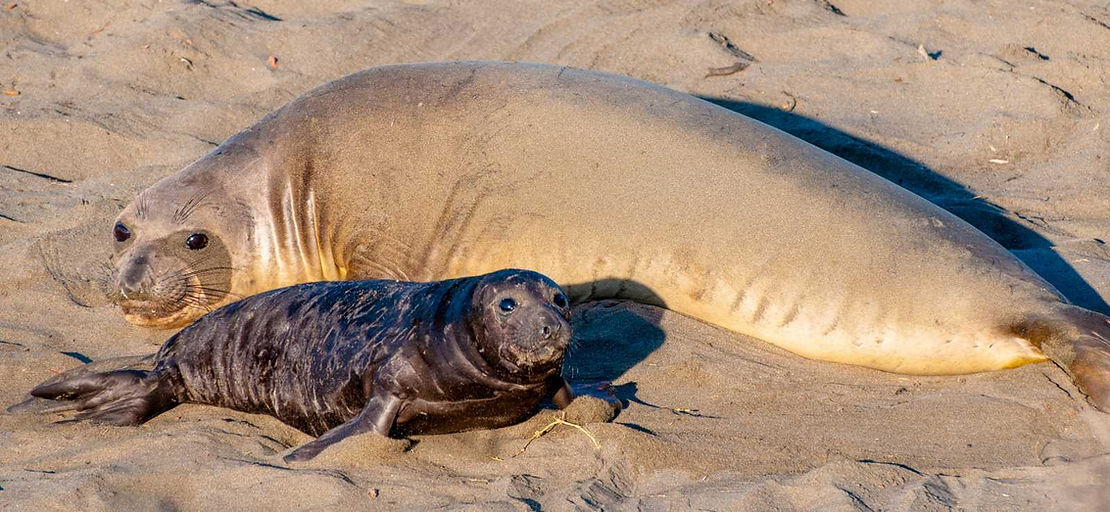By: Arthur Liao
Have you ever come across a strange looking seal that has a small elephant-like trunk? If yes, then you are probably staring right at an elephant seal! Northern Elephant seals live around the orthern Pcacific Coast of North America, and have many unique abilities. For example, an elephant can hold their breath for more than 100 minutes-longer than any non-cetacean mammal! Northern Elephant seals are magnificent and were once hunted to the brink of extinction for their blubber.
In the Water:
Northern Elephant seals can dive down to 1,550 m (5,090 ft) beneath the ocean’s surface– though the average depth of their dives is about 300 to 600 m (980 to 1,970 ft). Usually around 20 minutes for females and 60 minutes for males. A typical Northern Elephant seal can swim up to 10 miles an hour, but they usually swim slower to save up energy.
Heavyweight Champions:
A normal male elephant seal weighs roughly 4,400 pounds and a female elephant seal weighs about 1,300 pounds. That’s more than 2 times lighter than a male elephant seal. The heaviest elephant seal was a bull (male), and weighed almost 2 times a normal male elephant seal! His final calculated weight was 8,818! That’s more than 2 times the weight of a car (average car weight is 4,100 pounds according to the EPA).
Social Seals:
Similar to whales in Antarctica, elephant seals are highly social animals that love to get together in large groups. This is especially true during the breeding season, when they often form large gatherings that are known as harems. The harems will tend to have large numbers of females and a small number of males.
Various habitats:
Northern Elephant seals can also be found across the Antarctic region, but are most commonly prevalent (widespread in a particular area or at a particular time) on the Antarctic Peninsula and sub-Antarctic islands.
Favorite Food:
Their favorite foods depend on where they forage. Females in deep water tend to eat anternfish, hake and ragfish and, to a lesser extent squid. Males usually focus on fish that stay on the ocean bottom, such as dwelling skates, rays, squid, octopuses, eels, small sharks and large fish. Their stomachs most often contain gastroliths (stomach or gizzard stones). Gastroliths help with digestion and other ingestion difficulties that Northern Elephant seals might have.
Alive or Extinct:
Due to hunting, most people thought for a long time that the northern elephant seals had become extinct. Fortunately, this wasn’t the case. Now, from the small group of elephant seals that was left, there is an estimated population of 150,000 compared to the 20 to 50 individuals that were once left! Many live around the Baja Guld in Mexico and on the shores of Southern California, USA. These animals have grown from a small group of animals however, and as a result lack genetic diversity. There are also concerns over the future of these animals because of climate change, if the tides were to change, the seal colonies might have difficulties adapting. Thankfully, these magnificent creatures’ habitats are now protected by the law.
Their Name:
Northern elephant seals are called that for a number of reasons but mostly because of their size and because of the male snout (or trunk) that inflates to impress or intimidate rivals when competing with others for his harem (a group of females up to 5-50 associated with one male). The trunk is inflated with air which is inhaled and thus a loud bellowing sound is emitted to demonstrate how powerful he is, and lets the male avoid fighting against rival males.
Top Predators:
Although elephant seals seem large and intimidating, this doesn’t mean they have no predators. Their main predator is the orca, and in the northern parts of their living range, large sharks. Leopard seals have also been seen attacking and killing stray elephant seals young.
Bibliography:











